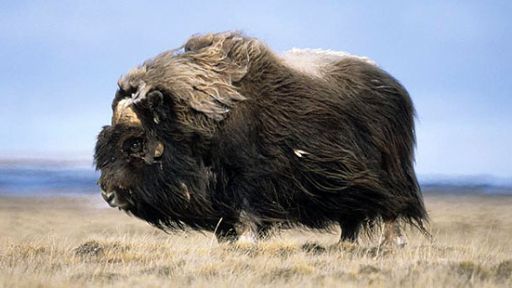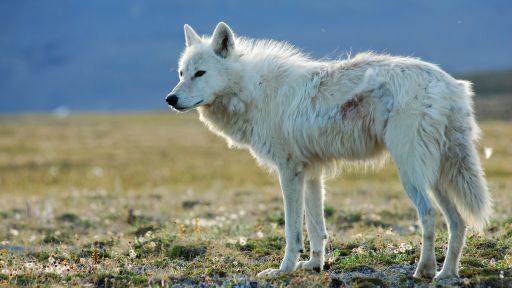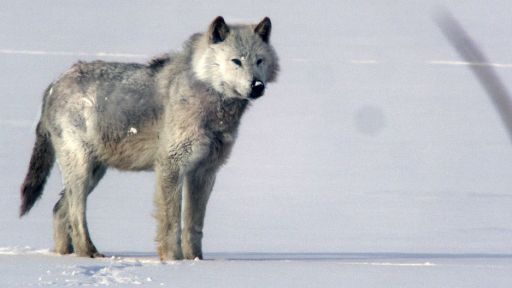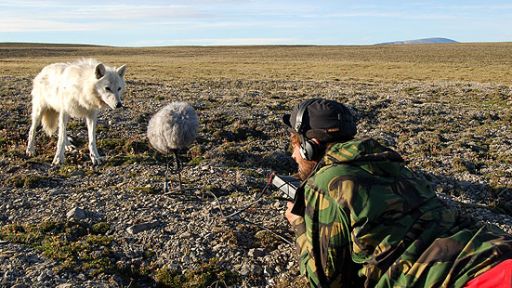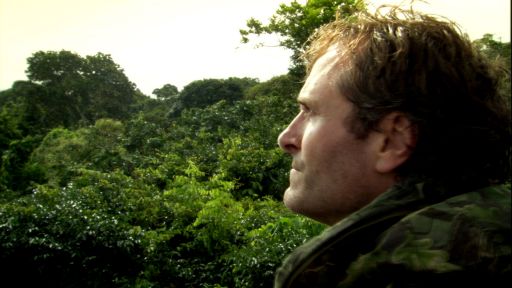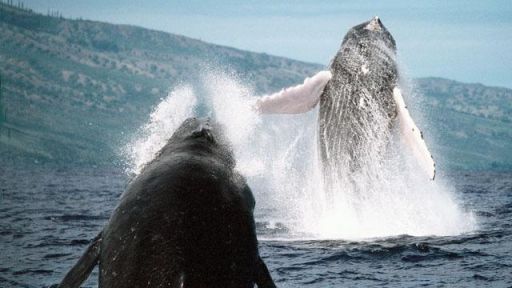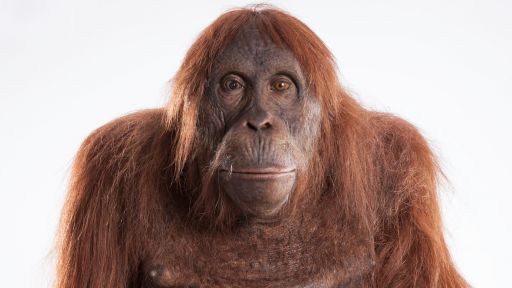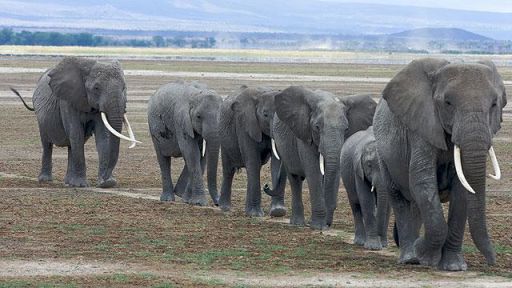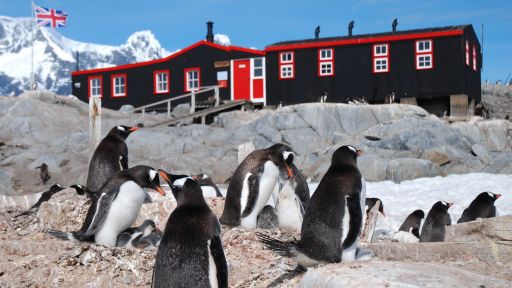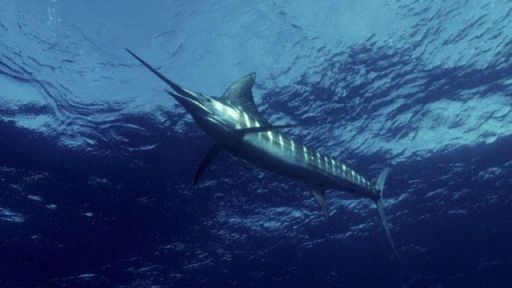Interview with Jonny Keeling, Director on location with wolves, musk oxen, hares and skuas
IRENE: Wolf territory can stretch hundreds of square miles. Did this make filming difficult for you?
JONNY KEELING: It was hard. It’s so vast, you can drive for hours. It’s always hard to imagine — all the sea ice is still frozen. You have this big brown landscape surrounded by ice. The brown landscape gets baked by the sun, like a plowed field, and you have to drive across bumps, apparently where moisture in the soil freezes.
With our Quad Bike (four-wheel motorbike) you can’t cross a massive river. The wolves can do it, but with the bike you can’t, so you’re looking for a place to cross, but by the time you find a way the wolves are gone. They have a lope, a trotting walk… And they would disappear for maybe five days, hunting, and they’d come back to the den, but you can’t follow.
A few times I tried to cross the river, and it would totally swamp me. There are moments you’re completely underwater. It can be scary. I suppose the biggest danger of those locations is the remoteness. If you have an accident, it’s a long time before someone gets to help you.
IRENE: How did you communicate with other crew?
JONNY KEELING: We had satellite phones. I’d tell Jim I‘m going to be here or there, see if I can find a fox den, and let him know when I’d be back. We’d know where the other person was, and have regular calls to each other.
IRENE: So there was a story about someone jerry-rigging caribou antlers onto a quad? Can you tell me about that?
JONNY KEELING: It was essentially dry in most places, but Jim (McNeill) got stuck in a boggy area one day, phoned in and said I’m stuck. We pulled him out with a rope. Next day he got stuck in a river and had to walk five miles back. He was all wet. The next day he goes to get the quad bike. He tried pulling it out, and the handles snapped off. The assistant producer, Harry (Hoskyns-Abrahall), used caribou antlers to make new handlebars. He drove it back but it was unusable after that. The next day, cameraman Mark Smith woke up and said “Oh great! Someone’s repaired the bike.” Unfortunately, he pulled the accelerator cable to attach it to the handlebars and it was revving very high, so when Mark turned it on it took off on its own and missed the camera by five feet. It just missed our tents too…Driving away by itself. Harry was the hero of the day, he managed to jump on and stuff…That bike wanted to drive on the tundra.
IRENE: What kind of cameras and lenses did you use?
JONNY KEELING: We took a regular HD camera and lens. You have to be super careful, the camera’s very fragile and on the quad it bounces, so Mark had to strap it on his back as he was standing on the quad bike trying to brace himself…
The light is really good there, and Mark was really good at capturing those moments. Twenty-four hours of daylight…the sun is whizzing around the sky, it dips slightly but doesn’t feel like it goes near the horizon. You don’t want to go to bed because it feels so exciting. And it plays with your body clock a bit. It’s better to work through the night because the light is slightly better.
IRENE: In the film, wolves are seen catching waterfowl. Is there more you can tell us about this behavior?
JONNY KEELING: Mark shot that with Harry when they went out for a day-and-a-half following wolves. When the wolves moved across the landscape they’d sometimes spread out and the youngsters would be playing, but they’re always interested in what’s around them. They’re kind of like naughty teenagers, like a gang, running around causing havoc.
There were times we’d look at the melting sea ice and it seemed impossible to move across. But a few days later, the wolves were there, jumping from piece of ice to piece of ice. They can go anywhere, they’re brilliantly adapted animals. It sounds soft, but talking about this here, I think about being back there. You kind of miss them even if you don’t have a relationship with them. You wonder — what are they doing now?
IRENE: Can you tell us a bit about filming the musk oxen and other wildlife in the film, such as skuas and hares?
JONNY KEELING: It’s very a different place to film, the animals are spread out far distances. When the quad bike stopped working, I had to walk like ten miles to get to the nearest hill to see if there were any animals. You’d walk towards the hares, and it could be another hour, and it’s amazing — like Alice in Wonderland — these giant hares that don’t walk away. Suddenly there’s this big, open, dusty landscape with these huge white animals there.
Sometimes, you’d turn around, walk back, wade and swim across the river. It was so cold and you’d achieve nothing, even though you’d walked 20 miles. Mark managed to find a fox den. The skuas were amazing, you’d see them when you walked, and they’d dive bomb you and land on you, trying to peck your head. I have shots of myself and Mark (while he’s filming) with skuas on our heads.
The musk oxen are amazing. They stare at you, and they come toward you and just stand there. You wonder — are they going to charge? It’s an incredible place to be. There are very few places where there is no sign of humans. You can sit there the whole day watching wolves. They’d come quite close. Some moments they were yards away, just staring. Have they been in contact with people before? Anywhere else in North America — and they’d run like crazy. It’s so otherworldly — so vast and open and the horizon is so big you almost feel like you’re on top of the earth.
It’s really good for your imagination. You come back and you walk on the city streets and realize how much you’re being bombarded by commercials…big billboards…It’s intense.
When you come back from a place like that you’re coming from the wilderness to “civilization” supposedly. You feel like you’re in another world, observing yourself as you walk down the road…Every sensation, every building, every noise is super-exaggerated. But then, after a few days, you’re back to being numb again.

